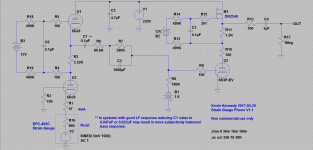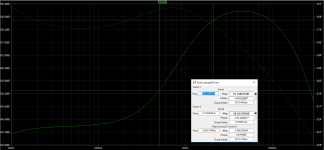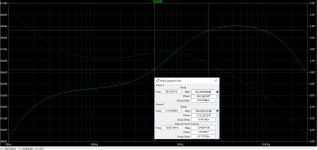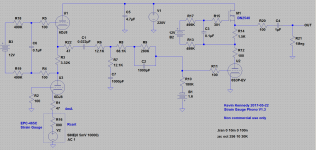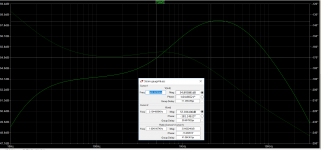You know where to get parts! Kevin, will a 6C4πEV work in place of the 6C3πEV?
John
Yes, that's a great sub, audio wise essentially identical.
Hey John, I have extra 6s3p even here if you guys need some.
Thanks, Dana! I already have a bunch of 6C4πEVs.
John
Here's the score (and a new schematic with trivial changes) - I am often reminded that some A23 batteries add an objectionable coloration to the sound which I would characterize as a nasality in the upper mids - most noticeable on female vocals, which as luck would have it is about 20% of what I listen to..
So I've added a little additional circuitry to decouple the battery from the audio path, this is two totally non critical (as to quality) resistors and a capacitor (where quality is important).
Russian surplus 200V teflon are applicable to at least the battery bypass. Type K72P-6 is what I used for battery bypassing in the first stage because it is what I had..
Most of the other caps are TRT Dynamicaps, the EQ cap is a REL PP foil. (tolerance matters - optimum results from about 920p - 1000p)
I am using Telefunken 6DJ8, I've found most Russian 6N23P to frankly not sound that great. I'd recommend modern equivalents from JJ..
I'm listening at the moment, sound is detailed, dynamic and well detailed without being obnoxious. I'm actually pretty impressed with this 45 year old cartridge.
Note: If you have a system with strong bass response below 50Hz you may want to reduce the value of C1 to 0.022uF - 0.047uF to tune the bass response to your system.
Second response plot reflects response where C1 = 0.022uF (I am using this value)
Please see post #73 for current recommended design
So I've added a little additional circuitry to decouple the battery from the audio path, this is two totally non critical (as to quality) resistors and a capacitor (where quality is important).
Russian surplus 200V teflon are applicable to at least the battery bypass. Type K72P-6 is what I used for battery bypassing in the first stage because it is what I had..
Most of the other caps are TRT Dynamicaps, the EQ cap is a REL PP foil. (tolerance matters - optimum results from about 920p - 1000p)
I am using Telefunken 6DJ8, I've found most Russian 6N23P to frankly not sound that great. I'd recommend modern equivalents from JJ..
I'm listening at the moment, sound is detailed, dynamic and well detailed without being obnoxious. I'm actually pretty impressed with this 45 year old cartridge.
Note: If you have a system with strong bass response below 50Hz you may want to reduce the value of C1 to 0.022uF - 0.047uF to tune the bass response to your system.
Second response plot reflects response where C1 = 0.022uF (I am using this value)
Please see post #73 for current recommended design
Attachments
Changed out C1 for a 0.022uF/5%/200V K72P-6, interesting while it did reduce
the overall bass response as expected (right for my system) it also resulted in somewhat
darker sound overall than I had expected. Seems in general to be a good compromise.
Great work. Will you measure the frequency or square wave response with a test record?
Once I get the new RTX I plan to do some test record pink noise measurements. I do not expect it to match the RIAA as well as my typical MM/MC based set ups simple because it is difficult to compensate perfectly for the response of these cartridges. Still learning as well, no doubt I will get better at it over time.
Sounds fairly good at this juncture.
Sounds fairly good at this juncture.
Hi Kevin, very neat circuit. I have not seen a strain gauge implemented in a grounded grid configuration before, this is clever. What do you think are the pro.s and con.s of this approach compared to the regular grounded cathode type approach?
A few other questions -
1. Your eq circuit in post #15 has 3.7 dB lift between 500 and 2.1k. But looking at your graph, in reality you have just a touch over 6dB treble boost from this circuit. I estimate around 4-6dB based on my listening tests, what is your target boost? It appears that we agree that theoretical boost of 12dB is too much.
2. In the second triode you use a DN2540 as a load, which is fairly standard. But since you have introduced battery bias you now have the option of using an enhancement mode device. Have you considered this option?
3. Since you have already made this into a hybrid circuit, why not use a DN2540 as load in the first stage? This will allow you to use a lower HV.
The Pana catridges do sound good, if you get a chance you should try a WIN cartridge - in my opinion they are even better (I have 2 WIN, a EPC451 and EPC460 so I have had the chance to compare them all with my balanced circuit).
Regards
A few other questions -
1. Your eq circuit in post #15 has 3.7 dB lift between 500 and 2.1k. But looking at your graph, in reality you have just a touch over 6dB treble boost from this circuit. I estimate around 4-6dB based on my listening tests, what is your target boost? It appears that we agree that theoretical boost of 12dB is too much.
2. In the second triode you use a DN2540 as a load, which is fairly standard. But since you have introduced battery bias you now have the option of using an enhancement mode device. Have you considered this option?
3. Since you have already made this into a hybrid circuit, why not use a DN2540 as load in the first stage? This will allow you to use a lower HV.
The Pana catridges do sound good, if you get a chance you should try a WIN cartridge - in my opinion they are even better (I have 2 WIN, a EPC451 and EPC460 so I have had the chance to compare them all with my balanced circuit).
Regards
Unfortunately I cannot claim any originality with regard to the unusual cartridge biasing scheme, I appropriated it from a design shared on Vinyl Engine. I did however carry it a couple of steps further - I designed a mu-follower which provides a lot more gain, and also configured it so that the actual operating point of the amplifier stage is predictable - in this case within 5% or better of 4mA.
Ideally I would have a rise of exactly 6dB between 500Hz - 2.12kHz. I've not mastered fractional pole/zero cancellation which would give me the ideal 3dB octave response I need. So I settled for some boost outside of the desired range which ultimately only gives me partial correction of the 6dB hole between the two RIAA time constants of 318us and 75us. Even worse is that the shelving boost adds a significant error above 2.12kHz which is substantial. I have a tentative correction which I will share in a following post.
All of this EQ is a swag based on studying the cartridge response curve and using conventional pole/zero, zero pole pairs to "improve" things. I am also not currently able to directly measure the cartridge/pre response, once some new test hardware arrives later this summer that issue should be at least partially resolved.
I used a DN2540 in the second stage as the depletion mode fet allows me to use larger source resistances and results in slighter higher load impedance reflected to the 6S3P-EV. I also have to drive 2.75 meters of interconnect so I wanted the high transconductance to lower the follower's output impedance as much as possible.
In the front end, the original pre-amp that died to make this (a Muscovite Mini III) had a cascode front end, so the other half of the 6DJ8 came for the ride free. I'm actually not a fan of hybrid tube designs, but from time to time I ignore my aversion in order to gain some tangible benefit.
Maybe you can provide some details wrt what to look for in a WIN cartridge. I know comparatively little about them, I don't even know if they have replaceable stylii.. What stylii are you using on your Panasonics?
Ideally I would have a rise of exactly 6dB between 500Hz - 2.12kHz. I've not mastered fractional pole/zero cancellation which would give me the ideal 3dB octave response I need. So I settled for some boost outside of the desired range which ultimately only gives me partial correction of the 6dB hole between the two RIAA time constants of 318us and 75us. Even worse is that the shelving boost adds a significant error above 2.12kHz which is substantial. I have a tentative correction which I will share in a following post.
All of this EQ is a swag based on studying the cartridge response curve and using conventional pole/zero, zero pole pairs to "improve" things. I am also not currently able to directly measure the cartridge/pre response, once some new test hardware arrives later this summer that issue should be at least partially resolved.
I used a DN2540 in the second stage as the depletion mode fet allows me to use larger source resistances and results in slighter higher load impedance reflected to the 6S3P-EV. I also have to drive 2.75 meters of interconnect so I wanted the high transconductance to lower the follower's output impedance as much as possible.
In the front end, the original pre-amp that died to make this (a Muscovite Mini III) had a cascode front end, so the other half of the 6DJ8 came for the ride free. I'm actually not a fan of hybrid tube designs, but from time to time I ignore my aversion in order to gain some tangible benefit.
Maybe you can provide some details wrt what to look for in a WIN cartridge. I know comparatively little about them, I don't even know if they have replaceable stylii.. What stylii are you using on your Panasonics?
OK, I have to confess that the shelving HPF filter approach bothered me at some level. I kept thinking that this approach results in further boosting the already substantial response above 2.12kHz. Turns out in discussions with several engineer friends that this suspicion was well founded. I have come up with a minor addition that introduces a pole and zero to knock down the response a bit above 2kHz, about 3dB at 9kHz.
All of this is an approximation as noted in the previous post, but sonically seems headed in the right direction.
The danger to those following the thread is that the design will continue to evolve - mostly in the area of the EQ, and I have not got this fully down at this point. I do feel I am moving in the right direction.
Edit: Please see post #73 for an improved version.
All of this is an approximation as noted in the previous post, but sonically seems headed in the right direction.
The danger to those following the thread is that the design will continue to evolve - mostly in the area of the EQ, and I have not got this fully down at this point. I do feel I am moving in the right direction.
Edit: Please see post #73 for an improved version.
Attachments
Slightly different conversation..
I have noticed that these cartridges, not surprisingly, are sensitive to VTA..
Tracing noise seems rather significant with a NOS shibata stylus and also is influenced by VTA to a significant degree.
Finally anyone one have experience with the current Jico SAS replacement? I can't help but question the condition of the rubber in the NOS replacement stylus, this is probably a 40yr old replacement. Is the Jico better or worse sounding/tracking than the original?
I'm not quite ready to spend for one of the better alternative stylii that are offered by various people for these cartridges.
I have noticed that these cartridges, not surprisingly, are sensitive to VTA..
Tracing noise seems rather significant with a NOS shibata stylus and also is influenced by VTA to a significant degree.
Finally anyone one have experience with the current Jico SAS replacement? I can't help but question the condition of the rubber in the NOS replacement stylus, this is probably a 40yr old replacement. Is the Jico better or worse sounding/tracking than the original?
I'm not quite ready to spend for one of the better alternative stylii that are offered by various people for these cartridges.
Late last night I decided to try the used conical stylus (cream colored grip) that came along with the cartridges, to my considerable surprise it sounds pretty good.
There was much less tracing noise and crackling with the conical and it seems less sensitive to VTA. Nice, smooth presentation, cleaner sounding overall.
I have another NOS shibata which try tonight in order to determine whether it is these shibatas in particular or just one of the two that are noisy. I suspect the shibata may need a further increase in tracking force as well. I'm currently running at 3.5 - 3.6gms and up to 4gms is recommended.
I'm now suddenly wondering how one of these would sound on the Schick (12 inch arm) attached to an 18gm AT Technihard shell. (That would put the overall mass in the right range for the Schick.) I might have to try it.
There was much less tracing noise and crackling with the conical and it seems less sensitive to VTA. Nice, smooth presentation, cleaner sounding overall.
I have another NOS shibata which try tonight in order to determine whether it is these shibatas in particular or just one of the two that are noisy. I suspect the shibata may need a further increase in tracking force as well. I'm currently running at 3.5 - 3.6gms and up to 4gms is recommended.
I'm now suddenly wondering how one of these would sound on the Schick (12 inch arm) attached to an 18gm AT Technihard shell. (That would put the overall mass in the right range for the Schick.) I might have to try it.
I think the "artificiality" I complained about in an earlier post was eradicated by the changes I made to the overall EQ last night. It is much more balanced sounding, detail that was somewhat obscured stands out.
It is interesting just how complex the EQ has become to address the known (and audible) deviations from ideal RIAA playback behavior. Given the very adhoc nature of my process and the EQ I have applied I would still expect deviations from ideal of at least +/-2dB which is nevertheless getting into the territory of well respected vintage SPUs and other LOMCs.
At this point in time sonically it does remind me a lot of a GM E II or possibly a Meister Silver GM II, however since both of mine are gone I will sprinkle a little salt on the supposition as no direct A/B is possible. Both the SPU A95 and Windfeld are better cartridges, but at a rather robust difference in price.
It is interesting just how complex the EQ has become to address the known (and audible) deviations from ideal RIAA playback behavior. Given the very adhoc nature of my process and the EQ I have applied I would still expect deviations from ideal of at least +/-2dB which is nevertheless getting into the territory of well respected vintage SPUs and other LOMCs.
At this point in time sonically it does remind me a lot of a GM E II or possibly a Meister Silver GM II, however since both of mine are gone I will sprinkle a little salt on the supposition as no direct A/B is possible. Both the SPU A95 and Windfeld are better cartridges, but at a rather robust difference in price.
- Home
- Source & Line
- Analogue Source
- Playing With Panasonic Strain Gauge Cartridges (And A Dedicated Phono Stage)
